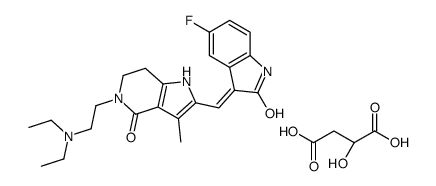Famitinib Malate
Modify Date: 2025-09-17 17:38:34

Famitinib Malate structure
|
Common Name | Famitinib Malate | ||
|---|---|---|---|---|
| CAS Number | 1256377-67-9 | Molecular Weight | 544.57200 | |
| Density | N/A | Boiling Point | N/A | |
| Molecular Formula | C27H33FN4O7 | Melting Point | N/A | |
| MSDS | N/A | Flash Point | N/A | |
Use of Famitinib MalateFamitinib malate (SHR1020 malate), an orally active multi-targeted kinase inhibitor, inhibits the activity of c-kit, VEGFR-2 and PDGFRβ with IC50 values of 2.3 nM, 4.7 nM and 6.6 nM, respectively. Famitinib malate induces cell apoptosis. Famitinib malate exerts powerful antitumor activity in human gastric cancer cells and xenografts, it can be used for the research of cancer[1][2]. |
| Name | 5-[2-(diethylamino)ethyl]-2-[(Z)-(5-fluoro-2-oxo-1H-indol-3-ylidene)methyl]-3-methyl-6,7-dihydro-1H-pyrrolo[3,2-c]pyridin-4-one,(2S)-2-hydroxybutanedioic acid |
|---|---|
| Synonym | More Synonyms |
| Description | Famitinib malate (SHR1020 malate), an orally active multi-targeted kinase inhibitor, inhibits the activity of c-kit, VEGFR-2 and PDGFRβ with IC50 values of 2.3 nM, 4.7 nM and 6.6 nM, respectively. Famitinib malate induces cell apoptosis. Famitinib malate exerts powerful antitumor activity in human gastric cancer cells and xenografts, it can be used for the research of cancer[1][2]. |
|---|---|
| Related Catalog | |
| Target |
VEGFR2:4.2 nM (IC50) PDGFRβ:6.6 nM (IC50) c-kit:2.3 nM (IC50) |
| In Vitro | Famitinib malate inhibits the VEGF-induced proliferation, migration and tubule formation of human umbilical vein endothelial cells, and micro-vessel spouting from matrigel-embedded rat aortic rings[1]. Famitinib malate (1.8 and 3.6 μM; 48 h) inhibits cell proliferation by inducing cell cycle arrest at the G2/M phase and causes cell apoptosis in a dose-dependent manner in gastric cancer cell lines[2]. Famitinib malate (0.6-20.0 µM; 24-72 h) inhibits gastric cancer cell growth in a dose-dependent manner[2]. Cell Proliferation Assay[2] Cell Line: Human gastric cancer cells BGC-823 and MGC-803 Concentration: 0, 0.6, 1.25, 2.5, 5.0, 10.0 and 20.0 µM Incubation Time: 24, 48 and 72 hours Result: Inhibited cell growth in a dose-dependent manner with IC50 values of 3.6 and 3.1 µM for BGC-823 and MGC-803 cells, respectively. |
| In Vivo | Famitinib malate exhibits broad and potent anti-tumor activity, leading to regression or growth arrest of various established xenografts derived from human tumor cell lines [1]. Famitinib malate (50 and 100 mg/kg; p.o. once daily for 3 weeks) reduces tumor growth in vivo via inhibition of angiogenesis[2]. Animal Model: 18-20 g female BALB/c athymic nu/nu mice (age, 6–8 weeks) bearing BGC-823 xenografts[2] Dosage: 50 and 100 mg/kg Administration: Oral gavage; 50 and 100 mg/kg; once daily for 3 weeks Result: Inhibited BGC-823 xenograft growth (tumor volume, 395.2 vs. 2,690.5 mm3), and animal weights were similar between groups (21.6 vs. 18.7 g). |
| Molecular Formula | C27H33FN4O7 |
|---|---|
| Molecular Weight | 544.57200 |
| Exact Mass | 544.23300 |
| PSA | 166.76000 |
| LogP | 2.22460 |
| Famitinib malate |
| Famitinib S-malate |